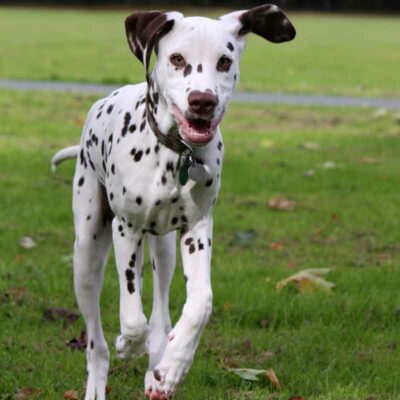The Dalmatian Dog breed

The Dalmatian is a sleek and medium-sized shorthaired dog characterized by its affectionate nature, high athleticism, exceptional intelligence, and boundless energy.
This dog breed is profoundly motivated, displaying unwavering loyalty, making it an ideal choice for both work and companionship.
Distinguished by its distinctive spots, slim physique, and elegantly arched tail, the Dalmatian has an intriguing history, including its iconic role as a firehouse dog and its fame from the Disney cartoon movie.
Characteristics of the Dalmatian
Dalmatians can prove to be exceptional companions, provided that the household comprehends their need for physical activity and training. They thrive in active environments, forming affectionate bonds with their human counterparts.
These dogs make delightful playmates for individuals or families who lead an active lifestyle.
History of the Dalmatian
The precise origins of the Dalmatian remain debated, although there is evidence of similar dog types dating back to ancient times. While its connection to the region of Dalmatia (modern-day Croatia) is doubtful, it is certain that Dalmatians once served as sentinels in that area, with historical artwork dating to the early 1600s.
Renowned for their affinity with horses, Dalmatians initially gained prominence in England as cherished carriage dogs. They would run alongside carriages to protect them and convey a sense of prestige. In addition to their role as carriage dogs, Dalmatians guarded stables during the night and played various roles as war dogs, guard dogs, retrievers, rat catchers, and shepherds. The first Dalmatian club was established in England in 1890, and the breed received recognition from the American Kennel Club (AKC) in 1888.
Dalmatians made their way to the United States around the early 20th century and became closely associated with teams of firefighters, especially during the era when horses were used to pull fire engines. These dogs would run ahead of the horses to clear paths of people and animals, allowing fire engines to reach fire scenes swiftly. This tradition endures, and Dalmatians are often seen as firehouse mascots. Furthermore, the Anheuser-Busch company incorporates Dalmatians in breeding farms and television advertisements featuring their Clydesdale horse teams.
The popularity of Dalmatians soared with Disney’s “101 Dalmatians” films and programs. Unfortunately, this led to irresponsible breeding and inappropriate adoptions, as many people could not manage the high energy levels of Dalmatians. Consequently, numerous Dalmatians were abandoned, prompting the formation of rescue organizations. The breed’s popularity waned after the initial surge, with AKC registrations decreasing by 90 percent in the decade following 2000.
Dalmatian Care
Dalmatians are highly agile, athletic, and versatile dogs, necessitating ample exercise and engaging activities to maintain their physical and mental well-being. In the absence of adequate exercise, they are susceptible to weight gain, anxiety, and behavioral issues. This breed can also be prone to excessive barking if their energy remains unchanneled.
Exercise
To ensure the well-being of a Dalmatian, it is crucial to provide at least two hours of exercise daily, encompassing a minimum of two walks and opportunities for running. A secure leash is essential when walking a Dalmatian due to their propensity for bolting if off-leash. Additionally, a secure enclosure is advisable.
Grooming
Dalmatians feature a smooth white coat adorned with distinctive black or brown spots. Puppies are born entirely white, and their spots develop as they mature. While their grooming needs are relatively basic, Dalmatians are known for their consistent shedding, which occurs year-round.
Regular brushing aids in managing shedding. The breed benefits from a natural resistance to dirt, allowing them to shed mud and debris quickly. Routine ear cleaning is essential to prevent ear infections, and maintaining neatly trimmed nails ensures comfortable and safe mobility for the Dalmatian.
Training
Dalmatians are renowned for their eager-to-learn nature, intelligence, and enduring energy. Although they may sometimes appear playful and even goofy, they are clever dogs requiring diligent and proper training.
The breed is notably receptive to training and possesses extended memory, making it vital to implement suitable training practices. Given their abundant energy levels, adequate training is crucial.
Common Health Problems
While responsible breeding practices aim to uphold the breed’s highest standards, Dalmatians can be prone to certain hereditary health issues. These may include:
- Deafness
Approximately 10 to 12 percent of Dalmatians are born deaf, with an additional 22 to 24 percent having hearing in only one ear. This condition is hereditary, and affected dogs should not be used for breeding. However, deaf Dalmatians can lead full and fulfilling lives. - Hip Dysplasia
An inherited condition that can result in lameness and arthritis. - Urinary Issues (infections, stones)
Dalmatians are predisposed to urinary problems, including stones, due to their excretion of higher uric acid levels. Adequate hydration and purine-restricted diets are essential to prevent such issues. - Skin Allergies
Dalmatians may exhibit allergies related to food, contact, or inhalation.
Diet and Nutrition
Feeding your Dalmatian entails two daily meals, with each serving consisting of 1.5 to 2 cups of dry dog food. Specialized low-purine dog food may be necessary to reduce the risk of kidney stones.
Regular access to fresh water is vital for preventing stone formation, and it is important to monitor your dog’s urination frequency. Consult with your veterinarian to ascertain the appropriate feeding schedule, food type, and quantity to prevent excessive weight gain.


